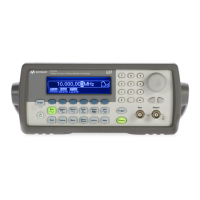264
Chapter 4 Remote Interface Reference
Calibration Commands
4
CAL:SECure:CODE <new code>
Enter a new security code. To change the security code, you must first
unsecure the function generator using the old security code, and then
enter a new code. The security code is stored in non-volatile memory.
• The calibration code may contain up to 12 characters. The first
character must be a letter (A-Z), but the remaining characters can
be letters, numbers (0-9), or the underscore character (“ _ ”). You do
not have to use all 12 characters, but the first character must always
be a letter.
CAL:COUNt?
Query the instrument to determine the number of times it has been
calibrated. Note that your instrument was calibrated before it left the
factory. When you receive your instrument from the factory, be sure to
read the count to determine its initial value.
• The calibration count is stored in non-volatile memory. The count
increments up to a maximum of “65,535” after which it rolls over
to “0”. Since the value increments by one for each calibration point,
a complete calibration may increase the value by many counts.
CAL:STRing <quoted string>
CAL:STRing?
Store a message in non-volatile calibration memory. Storing a message
will overwrite any message previously stored in memory. The :STR?
query reads the calibration message and returns a quoted string.
• The calibration message may contain up to 40 characters (additional
characters are truncated). An example is shown below.
CAL:STR 'Cal Due: 01 June 2009'
• You can record a calibration message only from the remote interface
and only when the instrument is unsecured. You can read the
message either from the front panel or over the remote interface.
You can read the calibration message whether the instrument is
secured or unsecured.
33210A users guide.book Page 264 Wednesday, July 16, 2008 11:16 AM

